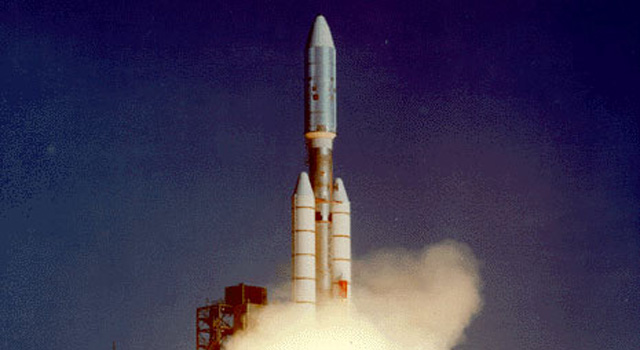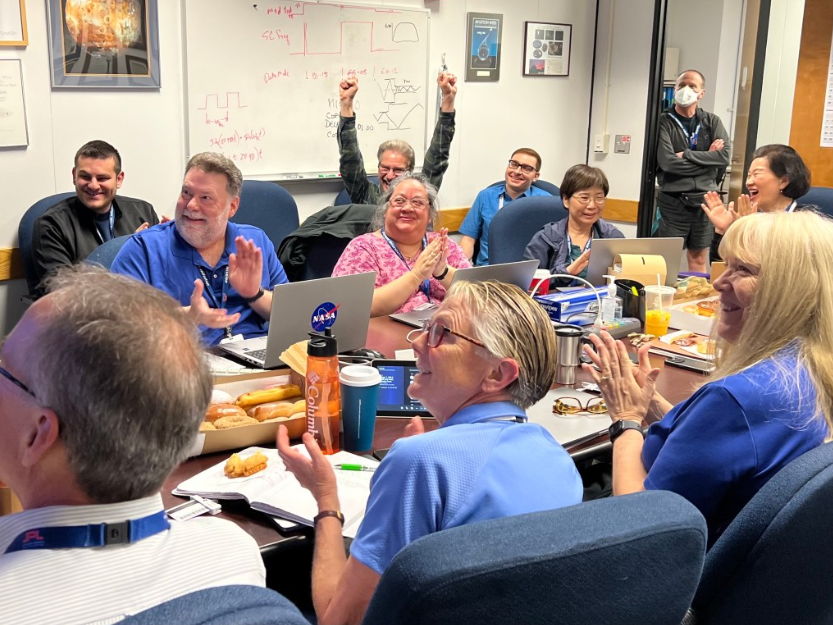
I was once sitting with my father while Googling how far away various things in the solar system are from Earth. He was looking for exact numbers, and very obviously grew more invested with each new figure I shouted out. I was thrilled. The moon? On average, 238,855 miles (384,400 kilometers) away. The James Webb Space Telescope? Bump that up to about a million miles (1,609,344 km) away. The sun? 93 million miles (149,668,992 km) away. Neptune? 2.8 billion miles (4.5 billion km) away. "Well, wait until you hear about Voyager 1," I eventually said, assuming he was aware of what was coming. He was not.
"NASA's Voyager 1 interstellar spacecraft actually isn't even in the solar system anymore," I announced. "Nope, it's more than 15 billion miles (24 billion km) away from us — and it's getting even farther as we speak." I can't quite remember his response, but I do indeed recall an expression of sheer disbelief. There were immediate inquiries about how that's even physically possible. There were bewildered laughs, different ways of saying "wow," and mostly, there was a contagious sense of awe. And just like that, a new Voyager 1 fan was born.
It is easy to see why Voyager 1 is among the most beloved robotic space explorers we have — and it is thus easy to understand why so many people felt a pang to their hearts several months ago, when Voyager 1 stopped talking to us.
Related: After months of sending gibberish to NASA, Voyager 1 is finally making sense again
For reasons unknown at the time, this spacecraft began sending back gibberish in place of the neatly organized and data-rich 0's and 1's it had been providing since its launch in 1977. It was this classic computer language which allowed Voyager 1 to converse with its creators while earning the title of "farthest human made object." It's how the spacecraft relayed vital insight that led to the discovery of new Jovian moons and, thanks to this sort of binary podcast, scientists incredibly identified a new ring of Saturn and created the solar system's first and only "family portrait." This code, in essence, is crucial to Voyager 1's very being.
Plus, to make matters worse, the issue behind the glitch turned out to be associated with the craft's Flight Data System, which is literally the system that transmits information about Voyager 1's health so scientists can correct any issues that arise. Issues like this one. Furthermore, because of the spacecraft's immense distance from its operators on Earth, it takes about 22.5 hours for a transmission to reach the spacecraft, and then 22.5 hours to receive a transmission back. Alas, things weren't looking good for a while — for about five months, to be precise.
But then, on April 20, Voyager 1 finally phoned home with legible 0's and legible 1's.

"The team had gathered early on a weekend morning to see whether telemetry would return," Bob Rasmussen, a member of the Voyager flight team, told Space.com. "It was nice to have everyone assembled in one place like this to share in the moment of learning that our efforts had been successful. Our cheer was both for the intrepid spacecraft and for the comradery that enabled its recovery."
And then, on May 22, Voyager scientists released the welcome announcement that the spacecraft has successfully resumed returning science data from two of its four instruments, the plasma wave subsystem and magnetometer instrument. They're now working on getting the other two, the cosmic ray subsystem and low energy charged particle instrument, back online as well. Though there technically are six other instruments onboard Voyager, those had been out of commission for some time.
The comeback
Rasmussen was actually a member of the Voyager team in the 1970s, having worked on the project as a computer engineer before leaving for other missions including Cassini, which launched the spacecraft that taught us almost everything we currently know about Saturn. In 2022, however, he returned to Voyager because of a separate dilemma with the mission — and has remained on the team ever since.
"There are many of the original people who were there when Voyager launched, or even before, who were part of both the flight team and the science team," Linda Spilker, a planetary scientist at NASA's Jet Propulsion Laboratory, who also worked on the Voyager mission, told Space.com in the This Week from Space podcast on the TWiT network. "It's a real tribute to Voyager — the longevity not only of the spacecraft, but of the people on the team."
To get Voyager 1 back online, in rather cinematic fashion, the team devised a complex workaround that prompted the FDS to send a copy of its memory back to Earth. Within that memory readout, operators managed to discover the crux of the problem — a corrupted code spanning a single chip — which was then remedied through another (honestly, super interesting) process to modify the code. On the day Voyager 1 finally spoke again, "you could have heard a pin drop in the room," Spilker said. "It was very silent. Everybody's looking at the screen, waiting and watching."

Of course, Spilker also brought in some peanuts for the team to munch on — but not just any peanuts. Lucky peanuts.
It's a longstanding tradition at JPL to have a peanut feast before major mission events like launches, milestones and, well, the possible resurrection of Voyager 1. It began in the 1960s, when the agency was trying to launch the Ranger 7 mission that was meant to take pictures of and collect data about the moon's surface. Rangers 1 through 6 had all failed, so Ranger 7 was a big deal. As such, the mission's trajectory engineer, Dick Wallace, brought lots of peanuts for the team to nibble on and relax. Sure enough, Ranger 7 was a success and, as Wallace once said, "the rest is history."
Voyager 1 needed some of those positive snacky vibes.
"It'd been five months since we'd had any information," Spilker explained. So, in this room of silence besides peanut-eating-noises, Voyager 1 operators sat at their respective system screens, waiting.
"All of a sudden it started to populate — the data," Spilker said. That's when the programmers who had been staring at those screens in anticipation leapt out of their seats and began to cheer: "They were the happiest people in the room, I think, and there was just a sense of joy that we had Voyager 1 back."

Eventually, Rasmussen says the team was able to conclude that the failure probably occurred due to a combination of aging and radiation damage by which energetic particles in space bombarded the craft. This is also why he believes it wouldn't be terribly surprising to see a similar failure occur in the future, seeing as Voyager 1 is still roaming beyond the distant boundaries of our stellar neighborhood just like its spacecraft twin, Voyager 2.
To be sure, the spacecraft isn't fully fixed yet — but it's lovely to know things are finally looking up, especially with the recent news that some of its science instruments are back on track. And, at the very least, Rasmussen assures that nothing the team has learned so far has been alarming. "We're confident that we understand the problem well," he said, "and we remain optimistic about getting everything back to normal — but we also expect this won't be the last."

In fact, as Rasmussen explains, Voyager 1 operators first became optimistic about the situation just after the root cause of the glitch had been determined with certainty. He also emphasizes that the team's spirits were never down. "We knew from indirect evidence that we had a spacecraft that was mostly healthy," he said. "Saying goodbye was not on our minds."
"Rather," he continued, "we wanted to push toward a solution as quickly as possible so other matters on board that had been neglected for months could be addressed. We're now calmly moving toward that goal."
The future of Voyager's voyage
It can't be ignored that, over the last few months, there has been an air of anxiety and fear across the public sphere that Voyager 1 was slowly moving toward sending us its final 0 and final 1. Headlines all over the internet, one written by myself included, have carried clear, negative weight. I think it's because even if Voyager 2 could technically carry the interstellar torch post-Voyager 1, the prospect of losing Voyager 1 felt like the prospect of losing a piece of history.
"We've crossed this boundary called the heliopause," Spilker explained of the Voyagers. "Voyager 1 crossed this boundary in 2012; Voyager 2 crossed it in 2018 — and, since that time, were the first spacecraft ever to make direct measurements of the interstellar medium." That medium basically refers to material that fills the space between stars. In this case, that's the space between other stars and our sun, which, though we don't always think of it as one, is simply another star in the universe. A drop in the cosmic ocean.
"JPL started building the two Voyager spacecraft in 1972," Spilker explained. "For context, that was only three years after we had the first human walk on the moon — and the reason we started that early is that we had this rare alignment of the planets that happens once every 176 years." It was this alignment that could promise the spacecraft checkpoints across the solar system, including at Jupiter, Saturn, Uranus and Neptune. Those checkpoints were important for the Voyagers in particular. Alongside planetary visits come gravity assists, and gravity assists can help fling stuff within the solar system — and, now we know, beyond.
As the first humanmade object to leave the solar system, as a relic of America's early space program, and as a testament to how robust even decades-old technology can be, Voyager 1 has carved out the kind of legacy usually reserved for remarkable things lost to time.

"Our scientists are eager to see what they’ve been missing," Rasmussen remarked. "Everyone on the team is self-motivated by their commitment to this unique and important project. That's where the real pressure comes from."
Still, in terms of energy, the team's approach has been clinical and determined.
"No one was ever especially excited or depressed," he said. "We're confident that we can get back to business as usual soon, but we also know that we're dealing with an aging spacecraft that is bound to have trouble again in the future. That's just a fact of life on this mission, so not worth getting worked up about."
Nonetheless, I imagine it's always a delight for Voyager 1's engineers to remember this robotic explorer occupies curious minds around the globe. (Including my dad's mind now, thanks to me and Google.)
As Rasmussen puts it: "It's wonderful to know how much the world appreciates this mission."
Originally posted on Space.com.







